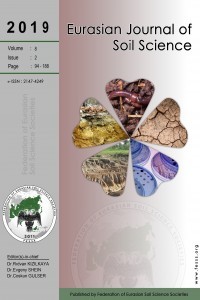
Eurasian Journal of Soil Science
Yazarlar: Guilhem BOURRİE
Konular:-
DOI:10.18393/ejss.12357
Anahtar Kelimeler:SAR,Sodium,Calcium,Clay,Swelling,ESP,Demixing,Sodium adsorption ratio
Özet: Sodium adsorption ratio SAR defined as SAR = (Na) / V w(Ca+Mg)/2 here concentrations of cations in solution are expressed in meq/L has long been considered as correlated to exchangeable sodium percentage (ESP) on clay minerals or soil exchange complex, and as the key concept to explain swelling of clay minerals and the difficulties of reclaiming salt-affected soils. Though its basis is empirical, it was alleged to be theoretically justified on the basis of ion exchange, derived from the Gapon convention. However, it has long been challenged on the basis of both field observations and experimental evidence : it fails to account for the fact that calcium and magnesium do not play the same role, while potassium is absent from the formula ; calcium concentration must be “corrected “when calcite is present etc. There exist specific ion effects. Experimental measurements of the decrease of permeability when solutions are diluted led Quirk and Schofield (1955) to define the concept of critical threshold, and to show that potassium and magnesium play an intermediate role between sodium and calcium. This threshold is simply determined by the concentration of calcium, irrespective of the value of SAR or ESP. Indeed, demixing of Ca-Na clay minerals during ion exchange, a phenomenon well known since Glaeser and Mering (1954), implies that there exists an interaction between adjacent sites. This undermines the theoretical basis of SAR : the derivation of SAR from ion exchange equilibria implies to use an equilibrium constant. This parameter is no more constant if demixing occurs. The results obtained are positive : demixing leads to expulsion of sodium from inner exchange surfaces and its replacement by calcium, according to the “three crystals pore”proposed by Quirk (2003b). Sodium can then be more easily leached, as permeability is maintained by clusters of Ca-sites. Calcium concentration in solution appears thus as the simpler parameter to guide saltaffected soils reclamation when swelling clays are present.
Dergi editörleri editör girişini kullanarak sisteme giriş yapabilirler. Editör girişi için tıklayınız.